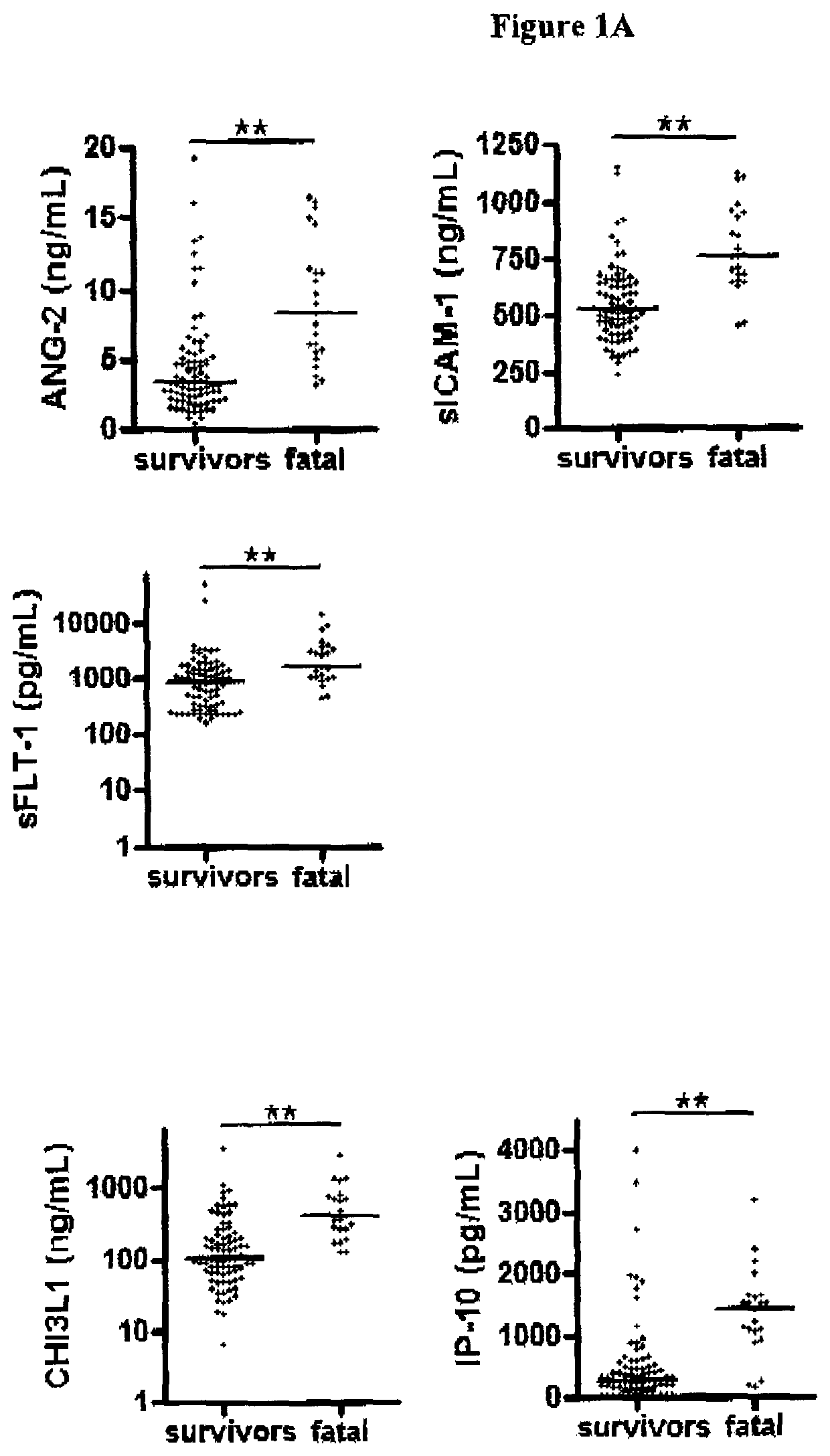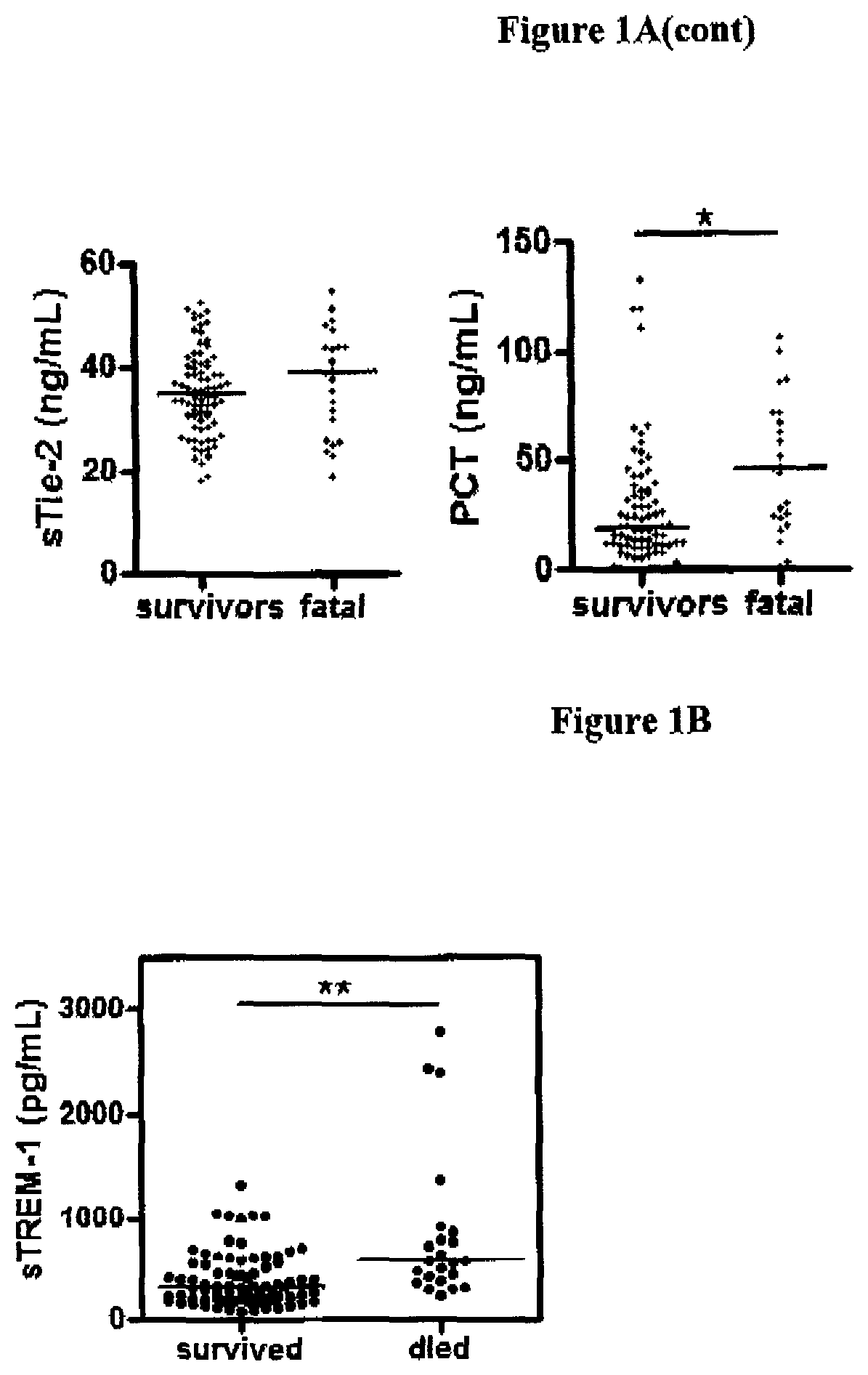Biomarkers for early determination of a critical or life threatening response to illness and/or treatment response
a biomarker and critical or life-threatening technology, applied in the field of biomarkers for early determination of critical or life-threatening response to illness and/or treatment response, can solve the problems of small proportions progressing to critical and/or life-threatening stages, difficult to determine who will do well without intervention, and only minimal
- Summary
- Abstract
- Description
- Claims
- Application Information
AI Technical Summary
Problems solved by technology
Method used
Image
Examples
example 1 individual
Biomarkers Predictive of Outcome in Pre-Diagnosed Malaria
[0103]A retrospective case-control study was performed at Mulago Hospital in Kampala studying children with malaria as the illness. Children were enrolled between the ages of 6 months and 12 years old who presenting with clinical signs and symptoms of malaria wherein the diagnosis was confirmed by detecting the presence of P. falciparum infections by microscopic analysis were utilized. Children with co-morbidities such as sickle cell trait / disease, HIV co-infection or severe malnutrition were excluded. Using plasma banked samples, various protein biomarkers were isolated and measured in the plasma from the approximately 100 Ugandan children where the diagnosis was confirmed as either cerebral malaria (CM) or severe malarial anemia (SMA) (both illness that can progress to life threatening disease). The levels of each of a selection of specific protein biomarkers was measured in the banked plasma samples and compared as between ...
example 2
Biomarker Combinations Predictive of Mortality in Pre-Diagnosed Malaria
[0110]Data was obtained as described in Example 1. The use of biomarker combinations improved the ability to predict the likelihood of an individual's life threatening response in malaria. In this example, a modest number of deaths in the study precluded using multivariable logistic regression analysis to create classifiers with more than 2-3 independent variables (Harrell F E, Jr., Lee K L, Mark D B (1996) Multivariable prognostic models: issues in developing models, evaluating assumptions and adequacy, and measuring and reducing errors. Stat Med 15:361-387). Therefore, as performed in other conditions, (Morrow D A, Braunwald E (2003) Future of biomarkers in acute coronary syndromes: moving toward a multimarker strategy. Circulation 108:250-252; Vinueza C A, Chauhan S P, Barker L, Hendrix N W, Scardo J A (2000) Predicting the success of a trial of labor with a simple scoring system. J Reprod Med 45:332-336), six...
example 3
Use of Classification Tree Analysis as an Alternative Classifier Predictive of Mortality in Pre-Diagnosed Malaria
[0120]To explore other synergistic combinatorial strategies, wherein weighting of each biomarker may vary, classification tree analysis was used, which selects and organizes independent variables into a decision tree that optimally predicts the dependent measure. Initially, a model based on IP-10 and sTREM-1 was generated with 43.5% sensitivity and 100% specificity for predicting mortality (FIG. 3). Since in some instances high sensitivity would be of particular importance, the analysis assigning the cost of misclassifying a death as a survivor was weighted as being 10 times greater than the cost of misclassifying a survivor as a death. A model based on IP-10, Ang-2, and sICAM-1 was generated with 100% sensitivity and 92.5% specificity for predicting outcome (cross-validated misclassification rate 15.4%, standard error 4.9%). In summary, combining dichotomized biomarkers ...
PUM
| Property | Measurement | Unit |
|---|---|---|
| volume | aaaaa | aaaaa |
| concentration | aaaaa | aaaaa |
| concentration | aaaaa | aaaaa |
Abstract
Description
Claims
Application Information
 Login to View More
Login to View More - R&D
- Intellectual Property
- Life Sciences
- Materials
- Tech Scout
- Unparalleled Data Quality
- Higher Quality Content
- 60% Fewer Hallucinations
Browse by: Latest US Patents, China's latest patents, Technical Efficacy Thesaurus, Application Domain, Technology Topic, Popular Technical Reports.
© 2025 PatSnap. All rights reserved.Legal|Privacy policy|Modern Slavery Act Transparency Statement|Sitemap|About US| Contact US: help@patsnap.com



